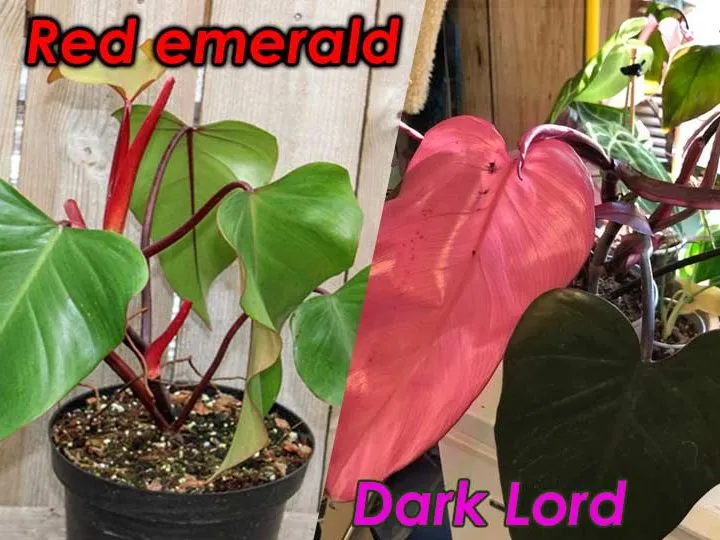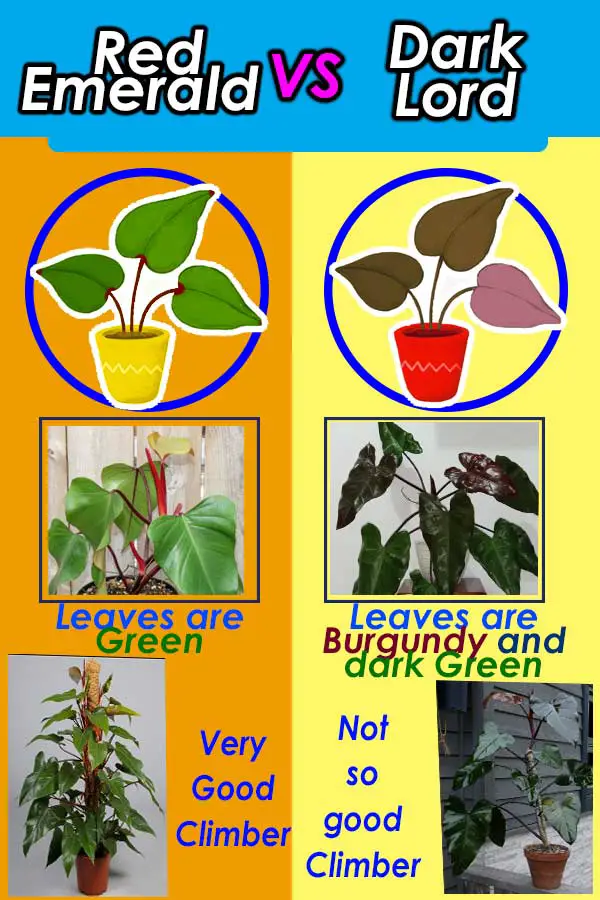
The dark lord philodendron and the red emerald philodendron are very similar. People get these two mixed up all the time because of their similarities. In this article, we look at the differences between these two philodendrons.
What are the differences between red emerald and philodendron dark lord?
The dark lord is a powerful plant with stunning colors. It has some of the best-looking foliage of the philodendrons. It is a dark-looking plant for the most part. The plant is also pink and also orange.
Philodendron red emerald is another super beautiful plant. It is currently a very trendy plant. Pink, red, and green are the main colors. There is a large variety of colors for the leaves, but it will often be a lighter green color. If rhubarb was a philodendron, it would be the red emerald philodendron. The likeness is uncanny. Both have delicious colored stems.

Leaves – Comparison
The leaves of the red emerald philodendron are green. You can be lucky and get yellow, marble, orange, or red leaves. Per usual the margin/edge of a red emerald leaf will be a deep dark red. You can identify the undersides of the plant. This is because the stem penetrates the underside and looks like a red nerves system. Mature plants have long Arrow-shaped leaves that look like hearts.
Philodendron dark lord “erubescens” has some of the darkest leaves in the family. A bright pink color can also develop. The leaves shoot out at orange or pink before it develops into a burgundy red or dark green nuance. In the beginning stages, the color will be a light choco color. In a typical fashion, the plant will have leaves of variating colors at the same time. This means the plant will be one of the most interesting-looking plants in your estate.
Stem differences
Philodendron dark lord is not a typical philodendron when it comes to the stem. It will often be Burgundy or Purple. It is not unusual to see completely pink or bright red stems. I find the Dark Lord to be one of the best philodendrons because it is too beautiful.
Not to say the red emerald doesn’t have beautiful foliage. It is also one of the more beautiful and interesting philodendrons.
The red emerald philodendron has sangria – wine-colored stems. Juvenile plants have a redder color. Whereas mature plants have darker and more brown-colored stems. Aged plants still have bright red colored branches
Size
The red emerald will never grow taller than 3 meters in indoor conditions. Out in the wild, it can be up to a stunning 50 meters tall if it grows up a tree. At this point, it becomes a mature epiphyte philodendron. Red emerald philodendron is around 3 feet tall in normal households. With extra care, it can become way bigger.
The dark lord philodendron is in general bigger than the red emerald. It will grow up to 6 feet tall and 4 feet wide. A mature plant can definitely take up a whole lot of space on your property. The firm stem and branching leaves will even grow pretty big in smaller pots.
Light – Lighting
Despite what you might think of dark leaves, the dark lord philodendron likes a lot of light. A whole lot of bright indirect light will make sure your plant thrives well. Sunburn is unlikely to happen if you don’t keep the plant in direct sunlight all day. Place the plant to give it direct sunlight in the morning or late afternoon. Your philodendron will thank you for this.
Like the dark lord, this rare Philodendron “red emerald” thrives in medium to bright indirect light.
Plant this plant in a place near a North or East facing window. Don’t place it in a southwest-facing window. Excessive sunlight can harm your houseplant and stunt its growth.
Light indicators for red emerald:
- Too much sunlight: Darkened or curled leaves
- Too little light: Pale leaves
Soil
I recommend using moist coco coir, perlite, and worm castings.
The two philodendrons will grow with the same soil mixture.
Despite what you might expect, pure normal soil is not good for philodendrons. Philos will drown in wet soil, but will also die in dry soil. Use coco coir and perlite together for great philodendron growing soil.
This mixture has
- Great drainage to prevent plants from drowning
- Fantastic aeration to give roots oxygen and prevent root rot
- Jungle like texture, which is great for philodendrons and monsteras.
Propagation
I use the same propagation method for all my philodendrons. It is a technique where you air layer the nodes to make air roots. SunnySideUp on youtube made a great video on this
100% safe method air layering propagation
- Find a branch you want to propagate. It should have 2 nodes and at least 1 leaf.
- Wrap sphagnum peat moss around the bottom node. Use plastic to wrap.
- Wait 10 days and make sure the moss is moist throughout
- The node should have air roots in the moss at this point.
- Plant the stem in moist light soil.
- Use neem oil on the plant for the next 2 weeks to keep it clean from disease
If 10 days pass and the air roots aren’t out yet, wait another 10 days. They should be out by now, but if they aren’t, then try again another time. This method has a near 100% success rate, as you can abandon it if there are no air roots.
Remember to treat the plant with neem oil. In this stage of development, the plant is most likely to die. Neem oil is great for pests and for insect management on potted plants. Make sure your plants won’t dry out in the beginning.
Watering
Both plants have the same watering schedule. The first step is to make sure you have perlite in your soil. Perlite is a holy grail for saving philodendron roots. They give good aeration and they can absorb excess moisture. Use perlite if you want to avoid root rot. Also, use coarse containers to be a green-fingered gardener.
Use a lot of water to feed your philodendron. Don’t worry much about overwatering your plants if you have good soil. Overwatering and root rot come more from bad drainage. High-frequency watering also increases root rot. Watering all the way through makes sure your roots get exposed to oxygen.
It can be dangerous to have a rigorous schedule for watering your plants. Instead, you should use your finder to measure the moisture. Some think you should use an instrument to measure moisture in the soil. They are most definitely wrong. Moisture meters can be far off, and other nutrients can influence its reading. Use your fingers instead.
The water content of the soil can deplete faster in some weeks compared to others. Temperature and amount of light influence how fast it dries. So don’t follow a rigid schedule.
You should use the knuckle test to measure moisture. Stick a finger into the potting soil. If you feel moisture at the first or second knuckle, you can delay your watering. If it is dry then water the plant.
You should use the same fertilizer on these plants. They should have the major nutrients nitrogen, phosphorus, and potassium. The best ratio for philodendrons is 7-9-5. With this ratio, your plants will grow big and strong. It is good to fertilize philodendrons, compared to plants like succulents. Many indoor plants don’t like being fertilized.
House plant vs outdoor?
They are both indoor and outdoor plants. In warm humid places, you can place your philodendrons outside all year round. The Caribbean and the Philippines are examples. You can grow the plants indoors all around the world, as long as you have heat and light. They will grow slowly in the winter and normally in the summer if you keep them indoors. In the summer you can actually place them outside, but make sure to check up on them and don’t give them too much sunlight
Climbing
Both are climbing, but the red emerald philodendron is much more of a climber than the dark lord. Give them a straight pole wrapped in sphagnum peat moss or coco coir. A lucky Bamboo is also enough. The moss and coco coir encourage the philodendrons to produce more air roots. You can use these air roots later for propagation.
The Dark Lord will climb up poles, but it prefers to grow wide compared to the thinner red emerald.
How is philodendron red emerald different from dark lord on origins?
The Dark lord philodendron is part of a giant plant family called “Araceae”, made of over 3000 species. It grows naturally in Meso America and it can also be found in the Philippines. This species is actually very popular in the Philippines. The plant has only recently gained popularity. For this reason, the plant is very rare and expensive on sites like Etsy.
Philodendron red emerald has a very similar history and origin like the Dark lord. It has grown naturally in Meso America, but it can be found anywhere warm and humid because of humans.
How is the red emerald different from the dark lord philodendron? – Conclusion
These two philodendrons are incredible. They look very similar. Their stems and leaves are the big differentiators. The dark lord is more expensive on Etsy. Both like to climb, but the red emerald is a much more avid climber.
Philodendron Dark Lord vs Black Cardinal
There are two main differences between the black cardinal and the dark lord philodendrons. The first is climbing. The dark lord will climb. It will climb much more than the black cardinal. Their shapes are different. Black cardinal will grow like a shrub, and won’t grow vertically. The dark lord will grow more upward. More like a regular philodendron and not like shrubs.
The second difference is the leaves. If you like gardening with these two plants, you will notice the differences in the leaves. The black cardinal has rounded leaves. The Dark Lord has long arrow-headed leaves. Black cardinal has leathery leaves, whilst the dark lord har sharper thinner leaves.
Make sure to check out our article on the Black Cardinal Philodendron

Philodendron Red Majesty vs Red Emerald
These philodendrons get mixed up often. There is a big difference between the red majesty and the red emerald. Like the imperial red, the red majesty grows like a shrub bush. But philodendron red emerald grows upwards and is a big climbing plant.
They have a lot of similarities though. They use the same compost and fertilizers. You can also use a similar potting mix in your greenhouse. The red majesty looks much more like a succulent, whilst the red emerald has vertical plant growth.
Both are beautiful houseplants that dislike garden soil. They thrive in humidity and are easy to repot. They should be watered thoroughly, unlike a cactus.
Philodendron Red Emerald vs Imperial Red
The imperial red and red emeralds are brothers genetically. Both are tropical indoor house plants that originally came from middle America. None are edible and are poisonous to most animals. Planters will spot the easy differences. The way they grow is very different. The imperial red will grow horizontal, whilst the red emerald will climb up stuff.
Another comparison
If you liked this comparison, you wanna check out our comparison on Cream Splash vs Brasil philodendron.
